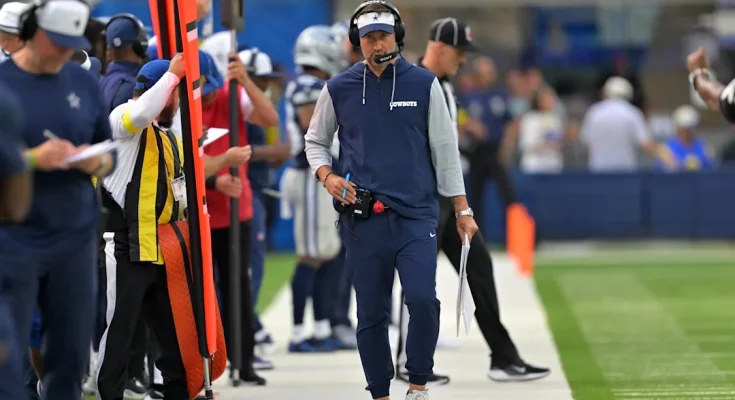The Dallas Cowboys have long been a team surrounded by immense expectations and passionate fanfare, but the recent evaluation of NFL coaching staffs has placed their coaching team dead last in future rankings, sparking a significant wave of debate and concern. This ranking, which weighs heavily on factors such as coaching acumen, adaptability, player development, and organizational vision, presents a stark contrast to the team’s lofty aspirations. Being positioned at the bottom is not only a reflection of perceived shortcomings but also a potential harbinger of difficulties in sustaining long-term success in the hyper-competitive landscape of the NFL.
To understand the implications of this ranking, it’s essential to first grasp the criteria that NFL future coaching staff rankings typically consider. These rankings go beyond mere win-loss records or even playoff appearances. They focus on the overall quality and potential of a coaching staff to build and maintain a competitive team in the coming years. Key elements such as innovative game planning, player development especially of young talent, the ability to adapt to evolving league trends, staff cohesion, and even front office synergy all come under scrutiny. The fact that the Cowboys coaching staff ranks at the very bottom in such a comprehensive evaluation is therefore a serious indictment of how NFL analysts and insiders view their current trajectory.
One of the primary criticisms aimed at the Cowboys’ coaching staff involves their offensive and defensive scheming. The NFL is constantly evolving, with offenses becoming more dynamic and defenses having to adapt rapidly to counter new trends. Coaches who fail to innovate or adjust to these shifts tend to fall behind. Critics argue that the Cowboys’ staff has demonstrated a stubborn adherence to outdated schemes and an inability to maximize the talents of their roster, particularly given the caliber of players on the team. This rigidity can stifle creativity and lead to predictable play-calling, which opposing teams can exploit. In a league where margins for error are razor-thin, a lack of tactical innovation severely hampers a team’s ability to contend.
Another focal point of criticism is the development, or perceived lack thereof, of the Cowboys’ young players. The NFL is a league that is increasingly driven by youth, with many teams rising quickly by nurturing their draft picks into star players. A coaching staff’s ability to identify potential and then cultivate it is vital for sustained success. The Cowboys, with a collection of high-profile young athletes, have been criticized for not adequately harnessing their growth. Some argue that the coaching staff’s developmental programs are lacking in depth and effectiveness, resulting in missed opportunities for talent to flourish and translate into on-field production. Without a robust player development system, the team risks plateauing or regressing despite the raw talent it possesses.
Moreover, questions about the cohesion and chemistry within the coaching staff itself have also surfaced. Successful teams often attribute much of their stability and on-field success to a well-synchronized coaching team. This includes not only the head coach but the coordinators and position coaches working in harmony towards a common vision. Reports and insider analysis suggest there may be disconnects within the Cowboys’ coaching hierarchy, leading to inconsistent messaging and execution on the field. When the coaching staff lacks a unified direction or clear communication, it creates confusion for players and undermines overall team performance.
The leadership style of the Cowboys’ head coach has been scrutinized in the wake of this low ranking. Leadership in the NFL coaching context involves not only managing players but also navigating the intense pressures from ownership, media, and fans. The head coach serves as the face of the coaching staff and is responsible for setting the tone and culture. Analysts have pointed out that the Cowboys’ head coach may struggle with these demands, which can contribute to an unsettled atmosphere around the team. Leadership deficiencies, whether in motivation, discipline, or strategic decision-making, inevitably reflect on the team’s results and future outlook.
This ranking also has significant ramifications for the Cowboys’ front office and their decision-making regarding coaching hires and support structures. The modern NFL emphasizes synergy between the front office and coaching staff to ensure that the team’s philosophy is aligned from drafting players to game-day execution. If the coaching staff ranks lowest in future projections, it raises questions about the front office’s judgment in assembling and maintaining the coaching team. It may suggest a lack of strategic vision or an inability to identify and retain coaching talent that fits the team’s long-term plans.
The fallout from such a low ranking could extend to player morale and recruitment. Players, especially top-tier free agents and draft prospects, consider coaching stability and staff quality when deciding where to commit their careers. A coaching staff viewed as ineffective or unpromising can deter talent from signing with the team or even cause existing players to seek opportunities elsewhere. This situation could hamper the Cowboys’ efforts to build a championship-caliber roster, perpetuating a cycle of underperformance.
It’s worth noting that the Dallas Cowboys operate under an intense media microscope and possess one of the largest fanbases in the NFL. This intense spotlight means that coaching decisions and performance are amplified and dissected in public forums regularly. The last-place ranking, therefore, not only influences internal organizational dynamics but also shapes the narrative among fans, analysts, and the broader football community. The pressure to respond decisively to such criticism is immense, and the Cowboys’ leadership must navigate this carefully to avoid further erosion of confidence.
Historically, the Cowboys have been a franchise that demands excellence and has seen great success, including multiple Super Bowl titles. The stark contrast between their storied past and the current low ranking of their coaching staff serves as a reminder that even the most iconic teams cannot afford complacency. The league is littered with once-great franchises that failed to evolve with the game, resulting in prolonged periods of mediocrity or worse. The Cowboys, given their resources and stature, have a high bar to meet, and this ranking serves as a wake-up call to address the underlying issues that have placed them at the bottom.
Looking forward, the Cowboys have options to reverse this negative trend. They can invest in upgrading their coaching staff by targeting innovative minds with proven records in development and scheme creativity. They could also reconsider their internal structures to ensure better alignment between the front office and coaching staff. Additionally, focusing on leadership development for current staff or bringing in experienced mentors might help elevate the team’s strategic approach and culture.
The question remains how patient the ownership and fans will be as the Cowboys work to rebuild their coaching reputation. In the NFL, coaching tenure can be short if results don’t come quickly. While building a sustainable winning culture takes time, the pressure to deliver immediate improvements is unrelenting. The Cowboys’ leadership will have to balance these competing demands carefully to regain respect and position their coaching staff among the league’s elite once again.



